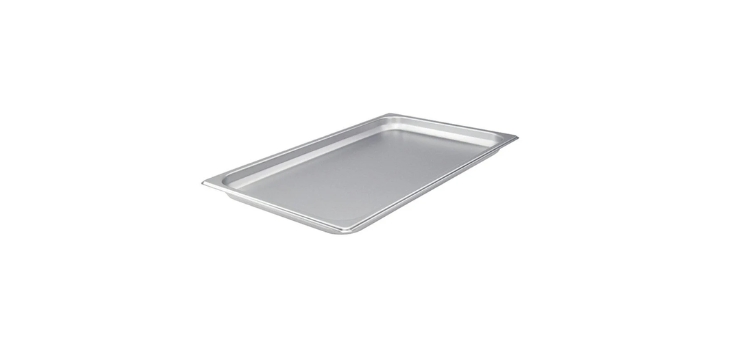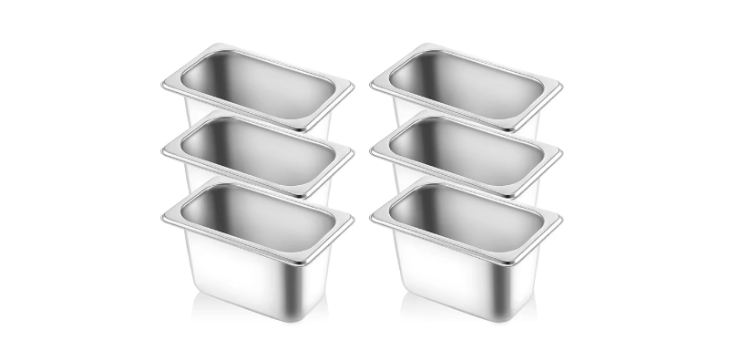As an Amazon Associate, I earn from qualifying purchases

Steam table pans, also known as hotel pans or service pans, are indispensable in the culinary world, playing a vital role in both catering and food service industries. These versatile tools are primarily used to prepare, store, and serve food, facilitating buffet-style dining and large-scale meal preparation.
As a staple in commercial kitchens, understanding the capabilities and limitations of steam table pans is essential, particularly regarding their use in ovens. This article delves into whether steam table pans can safely go in the oven, exploring their materials, potential risks, and providing practical tips for their optimal use.
Materials Used in Steam Table Pans
Steam table pans are crafted from a range of materials, each with distinct properties affecting their performance and suitability for oven use.
Commonly Used Materials
- Stainless Steel: Stainless steel is the most prevalent material for steam table pans due to its durability, resistance to corrosion, and ability to withstand high temperatures. Its strength makes it ideal for holding hot foods over extended periods without warping.
- Aluminum: Aluminum pans are valued for their excellent heat conduction, which ensures even cooking. They are lightweight and generally more economical than stainless steel. However, aluminum is more prone to warping at very high temperatures compared to stainless steel.
Heat Resistance Properties
- Stainless Steel: Known for its robustness, stainless steel can generally endure oven temperatures up to 500°F or more, depending on the gauge and construction quality.
- Aluminum: While aluminum conducts heat efficiently, it is typically limited to oven temperatures around 450°F. Manufacturers often specify the maximum safe temperature on the packaging or product description.
Potential Risks and Safety Considerations

Using steam table pans in the oven involves certain risks that must be managed to ensure safety and food quality.
Risks of Using Steam Table Pans in the Oven
- Warping: Both stainless steel and aluminum can warp if subjected to sudden temperature changes, such as moving from a freezer to a hot oven. Warping can cause uneven cooking and potential spills.
- Food Contamination: If a pan is not properly cleaned or maintained, residues can burn in the oven, affecting food flavor and safety.
- Coatings and Additives: Some pans might have coatings or non-metal components, like handles or edges, that are not oven-safe and can melt or release toxins when heated.
Guidelines for Preventing Damage and Ensuring Safety
- Always check manufacturer guidelines for maximum oven-safe temperatures.
- Avoid sudden temperature changes by allowing pans to come to room temperature before placing them in the oven.
- Inspect pans for any coatings or non-metal parts that might not withstand oven temperatures.
Practical Tips for Using Steam Table Pans in the Oven
Adhering to best practices can enhance the safety and effectiveness of using steam table pans in the oven.
Best Practices for Safe Oven Use
- Use pans in the oven only if they are clearly labeled as oven-safe.
- Preheat the oven and ensure that the pan is compatible with the intended cooking method.
- Avoid stacking pans in the oven unless they are designed to do so, to ensure even heat distribution.
Precautions to Take
- Regularly inspect pans for dents or warping that could impact performance.
- Use oven mitts or towels to handle pans, as both stainless steel and aluminum can become extremely hot.
- Consider placing a sheet pan underneath to catch any potential spills and prevent messes.
Conclusion
Steam table pans are versatile and valuable kitchen tools, capable of handling a variety of tasks from preparation to serving. Understanding the materials these pans are made from, such as stainless steel and aluminum, and their respective heat resistance, is crucial for safely incorporating them into oven use.
By acknowledging potential risks like warping and food contamination and adhering to best practices, you can maximize the use and longevity of your steam table pans. Whether you’re baking lasagna for a family gathering or roasting vegetables for a buffet, these pans can be a reliable ally in your culinary endeavors. Always consult manufacturer guidelines and apply practical safety tips to explore the full potential of steam table pans in your cooking adventures.
FAQ
Can you bake in disposable steam table pans?
Yes, you can bake in disposable steam table pans. These aluminum pans are designed for high heat and make cleanup easy. However, ensure even support to prevent warping, and avoid sudden temperature changes to maintain their shape and effectiveness during baking.
Is a steam pan oven-safe?
Steam pans, typically made of stainless steel or aluminum, are often oven-safe. However, it’s essential to check specific manufacturer guidelines for maximum temperature limits. Avoid using pans with non-metal components or coatings that aren’t designed for oven use to prevent damage or contamination.
What are steam table pans used for?
Steam table pans are versatile kitchen tools used for storing, serving, and preparing food, especially in buffet settings or large-scale catering. They are ideal for maintaining food temperature, organizing ingredients, and even cooking in some cases, making them indispensable in professional kitchens.
Can hotel pans be used in the oven?
Yes, hotel pans, another term for steam table pans, can generally be used in the oven. Made from stainless steel or aluminum, they withstand high temperatures. Always confirm their oven-safe status and follow best practices, such as avoiding sudden temperature changes, to ensure safety and performance.
As an Amazon Associate, I earn from qualifying purchases